Supermarket goods are often supplied by Fast-Moving Consumer Goods (FMCG) companies, or companies that produce foods, beverages, household and personal care.
With consumers becoming more environmentally aware (yay!), these FMCG companies are starting to understand the importance of adapting to changing customer trends and are becoming more transparent with their value chain, by adopting certification schemes.
One of the easiest ways to determine whether products were derived and produced sustainably is to check for sustainability certification! These certification schemes are usually accredited by individual bodies, which check for several criteria to be met.
This includes the sourcing of raw materials or surveying the conditions of workers involved in every process. When awarded these certifications, brands are then allowed to print the respective certification labels on their products to encourage consumers to make responsible, conscious decisions.
There are so many sustainable certification schemes and accreditations out there. The Ecolabel Index, the largest directory of ecolabels, identifies more than 460 green labels across 25 different sectors.
This post will focus on the more prominent certification schemes you may come across in Singapore’s supermarkets, and how these products can help you be more aware of sustainability issues!
Wood-based products: Forest Stewardship Council Certification
The Forest Stewardship Council (FSC) is a standard-setting body that promotes responsible forestry. Founded in 1993, FSC certifies forests all over the world to ensure they meet the highest environmental and social standards.
These specifications include reducing the environmental impact of logging activities, and maintaining ecological functions, integrity, and sustainability of the forests from where timber is harvested.
While other standards for forested products exist, FSC is the most widely accepted global standard for wood and wood-related products.
It’s currently the forest certification scheme that best fulfills WWF’s requirements as a credible certification system, due to its unique emphasis on aligning social, environmental and economic pillars with stakeholder interests.
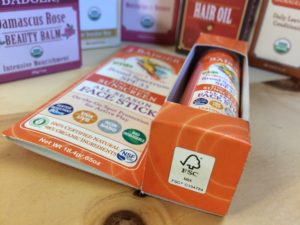
Products made with wood and paper from FSC forests are marked with FSC’s ‘tick tree’ logo. Source: https://blog.badgerbalm.com/fsc-speaks-trees/
The FSC label can also be found on non-timber forest products including natural latex, cork and bamboo. Interestingly enough, because the FSC was established with trees and forests in mind, FSC does not directly relate to bamboo, with it being a grass and not a tree!
Simplybamboo argues that ensuring bamboo is certified does not value-add to the already sustainable system of bamboo harvesting today.
This is because bamboo plantations are already small-scale owned and sold directly into the supply chain. This ensures fair and sustainable trade as long as they are harvested during the growing season.
In the supermarket, products most likely to hold the FSC labels are your tissues and toilet paper!
Did you know, the paperboard from Tetra Pak’s packaging material (the paper cartons used for milk and other beverages) are from FSC-certified forests, as well as other controlled sources too?
Differences Between FSC Labels
Here are three most common FSC labels that differ slightly from each other:
| 100% | RECYCLED | MIX |
 |
 |
 |
| The wood within the product comes completely from FSC-certified well-managed forests | All the wood or paper in the product comes from reclaimed (re-used) material | The wood within the product is from FSC-certified forests, recycled material, or controlled wood |
FSC 100% is of the highest tier, and FSC MIX is the lowest. When not specified, you can assume that the product is of the lowest tier on the FSC labelling system!
Snacks and products – Roundtable on Sustainable Palm Oil
The Roundtable on Sustainable Palm Oil (RSPO), established in 2004, has the primary objective of promoting the growth and use of sustainable palm oil.
This is achieved through cooperation and open dialogue between stakeholders within the palm oil supply chain, though not easily achieved due to the complexity of the supply chain, from the plantations in the tropics to retailing products globally.
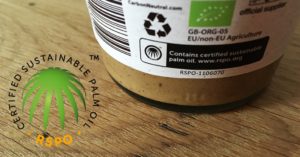
The RSPO logo on a peanut butter jar. This logo proves that the palm oil used in this product has been harvested sustainably! Source: https://twitter.com/rspotweets/status/847047444605157379
However, the RSPO has come under various forms of criticism. One major issue critics have is the multi-stakeholder approach required to ensure credibility of the sustainability claim at the end of the supply chain. Due to the many stakeholders involved, the pace of change is slow.
Also, if you ever come on board with our physical Shopping For Sustainability walks, you may find notice that RSPO-certified snacks are rather hard to find when walking around the snacks section of the supermarket!
Because organisations taking legal ownership and handling RSPO-certified palm oil products require supply chain-certified, RSPO’s performance level is low.
As a result, few products at the end of the supply chain can be labelled sustainable, due to the numerous members that need to come to a consensus.
Look For Snacks And Products With RSPO Certification!
As a consumer, it is still best to get products with the RSPO certification where possible!
You can refer to WWF’s Palm Oil Scorecard, where WWF scored 137 major companies on their use of sustainable palm oil. This website shows whether the companies surveyed are taking the right actions to reduce unsustainable palm oil use.
While you can substitute palm oil-containing products in the short term, do note that boycotting products containing palm oil entirely is ultimately not a solution.
Palm oil is the most efficient oil crop. It is the growing practices of the oil palm that is the problem, and not the plant itself.
Seafood – MSC and ASC
Did you know that with our high demand for seafood, humans are depleting our fish stocks in oceans on a global scale?
Unsustainable fishing is happening due to poor fishery management, capturing of juvenile fish. And also not giving fish stocks ample time to replenish itself. WWF has a great article that provides a good insight on our diminishing fish stocks – read more here!
Therefore, the Marine Stewardship Council (MSC) was founded to certify seafood harvested sustainably. The MSC works at all levels of the supply chain, from the fisheries to the consumers, to get them to buy into its sustainable certification scheme.
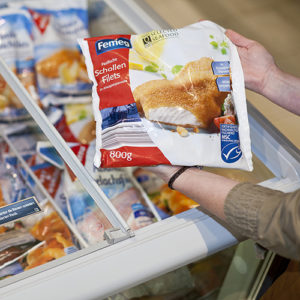
If you see this logo on your seafood product, it has been harvested from sustainable fish stocks. Source: https://www.msc.org/what-you-can-do/eat-sustainable-seafood/fish-to-eat
The MSC identifies three guiding principles in accreditation processes: ensuring sustainable fish stocks, minimising the environmental impact of the fishing activity, and effective fisheries management, through which fisheries must meet 28 performance indicators to achieve the MSC Fisheries Standard.
In August 2019, is was reported that there are over 60 MSC-labelled products available in our local supermarkets, as well as sustainable seafood species!
Aquaculture Stewardship Council
Another, perhaps less common certification, is the Aquaculture Stewardship Council (ASC).
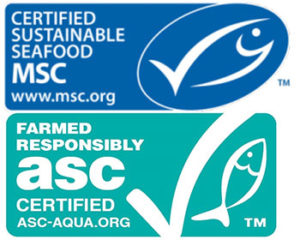
Notice the differences between the MSC and ASC labels! The ASC certifies that the seafood you eat is grown in a sustainable manner. Source: https://fis.com/fis/worldnews/worldnews.asp?l=e&id=77462&ndb=1
Aquaculture has been touted as one of the world’s fastest growing food industries as a solution to easing pressure on fish stocks, but has proven to cause other sustainability issues including habitat destruction, the excessive use of valuable freshwater on rearing fish, and high mortality rates.
As such, the ASC, also seen in Singapore’s grocery stores, helps fish farms promote responsible and environmentally sustainable fish farming.
Singapore Green Labeling Scheme
The Singapore Green Labeling Scheme (SGLS) is a certification scheme tailored to fit products available locally!
It was launched in May 1992 by the Singapore Environmental Council. And it endorses both industrial and consumer products that meet eco-standards specified by the scheme.
Businesses seeking to apply for the Green Label must undergo an independent third-party assessment of product environmental attributes. This varies depending on the category the product falls under.
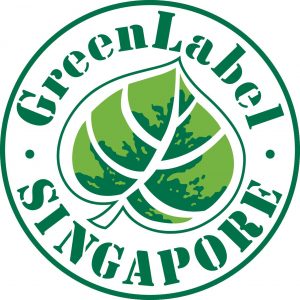
The SGLS covers a wide range of industrial consumer products, from paper to personal care! However, it does not label snacks and other food products. Source: http://secs.sg/singapore-green-labelling-scheme/
When Singapore was severely affected by the transboundary haze pollution back in 2015, the SEC suspended the Green Label on Asia Pulp and Paper (APP)’s products due to the company’s possible link to the haze-causing forest fires!
This resulted in their products, comprising mainly of tissues and toilet paper, being pulled of supermarket shelves. This resulted in the Enhanced Singapore Green Label Scheme, an improved version of the original scheme, and APP’s was successfully awarded the Green Label due to their newfound commitment to zero deforestation and no new plantation on peatlands.
Conclusion
As a conscious consumer, do understand that certifications do have their limitations as well! Some certification schemes have been criticised for blocking true sustainability by watering down standards in order to get stakeholders on board.
For instance, a lot of Singapore’s palm oil in snacks is from Indonesia and Malaysia, which have their own national palm oil schemes. Which are much weaker than other standards.
This means that they label palm oil as “sustainable” very easily. Investigations have also revealed possible inaccuracies in labeling and certification.
Effective certification schemes need strong operational standards and criteria to ensure positive impacts are delivered. Also, a strong governance system to regulate the certification process.
In any case, certification schemes are still a step forward in encouraging business transparency with their product value chain. The main key takeaway is to prioritise certified products! This will encourage companies to meet that demand and work to become certified!
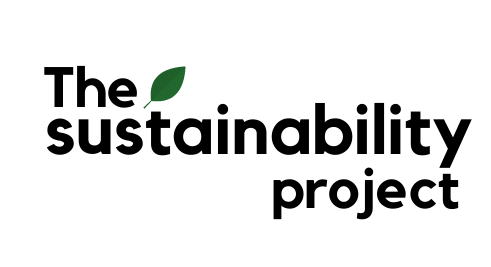

There is noticeably a bundle to learn about this. I assume you made certain good factors in options also.
But maybe you could a little more in the way of content so people could connect with it better. Youve got an awful lot of text for only having 1 or 2 pictures. Maybe you could space it out better?